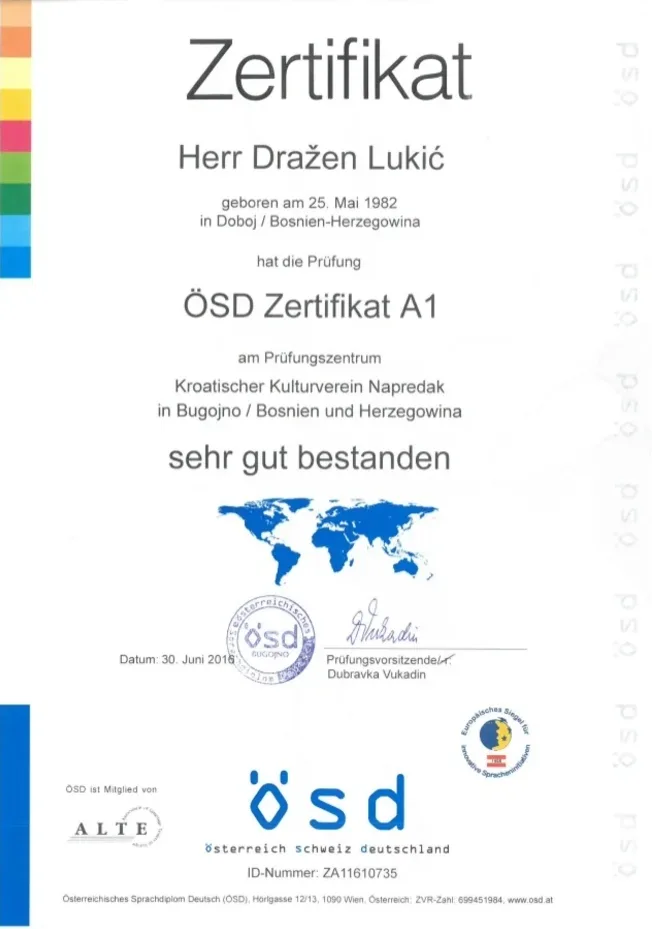Comprehending the ÖSD Certificate A1: What You Need to Know
In a progressively interconnected world, the ability to interact in multiple languages has ended up being a valuable property. For people seeking to demonstrate their proficiency in the German language, the Austrian Language Diploma (ÖSD) offers a structured and recognized certification program. Among the different levels of this accreditation, the ÖSD Certificate A1 functions as the entry point for beginners. This short article dives into the credentials of the ÖSD A1 certification, its function, structure, and significance, together with answers to some frequently asked questions.
What is the ÖSD Certificate A1?
The ÖSD Certificate A1 is a foundational language proficiency test developed to determine a prospect's capability to communicate in standard German. It falls under the Common European Framework of Reference for Languages (CEFR), which offers a standardized scale for evaluating language proficiency. The A1 level is classified as the starting phase, where people are expected to understand and use familiar daily expressions and basic expressions focused on satisfying useful requirements.
Significance of the ÖSD Certificate A1
The ÖSD Certificate A1 has a number of important ramifications for individuals wanting to boost their language skills and enhance their personal and professional potential customers. Here are a few factors why this accreditation is considerable:
Foundation of Language Learning: The A1 level acts as a stepping stone for learners who wish to advance to higher levels of proficiency in German.
International Recognition: The ÖSD certificates are commonly recognized in Austria and Germany, increasing employability in German-speaking countries and strengthening visa applications.
Assessment of Basic Skills: The exam examines important skills in reading, writing, listening, and speaking, providing learners a clear understanding of their linguistic capability.
Structured Learning Path: Obtaining the A1 certificate sets the groundwork for learners to systematically construct their language skills.
Structure of the ÖSD Certificate A1
The ÖSD Certificate A1 consists of 4 main elements that evaluate various language abilities:
Listening Comprehension (Hörverstehen):.
Prospects listen to taped discussions and brief texts. They need to answer questions that evaluate their understanding and ability to extract important details.
Checking Out Comprehension (Leseverstehen):.
This segment includes checking out brief texts, discussions, or advertisements, followed by concerns that examine understanding and interpretation.
Composed Expression (Schreiben):.
In this part, students need to produce brief composed texts, such as completing forms or writing easy messages, demonstrating their ability to communicate in writing.
Oral Expression (Sprechen):.
Prospects take part in a conversation with an inspector, which can consist of answering concerns about personal subjects, describing familiar things, or going over everyday circumstances.
Getting ready for the ÖSD Certificate A1.
Success in the ÖSD A1 assessment requires sufficient preparation. Here are some tips for effective research study:.
Research Study Materials: Utilize ÖSD-approved books, online courses, and practice tests specifically developed for the A1 level.

Expand Vocabulary: Focus on vocabulary associated to everyday subjects such as household, tasks, foods, and hobbies.
Practice Listening: Engage with German-speaking media, including podcasts, movies, and tunes, to enhance listening skills.
Discussion Practice: Join language exchange programs or groups to practice consulting with native speakers or fellow students.
Mock Tests: Regularly total practice tests to acquaint oneself with the exam format and time constraints.
Advantages of Earning the ÖSD Certificate A1.
Attaining the ÖSD A1 certificate not only validates one's language abilities however also unlocks different opportunities for individual and professional growth. Here are some advantages of holding this certification:.
Boosted Job Opportunities: Many employers in German-speaking nations worth language accreditation, particularly at the A1 level, as it shows dedication to communication.
Admission to Language Courses: Some language schools need evidence of A1 proficiency as a prerequisite for advancing to greater courses.
Confidence in Communication: The certificate increases self-confidence in fundamental interaction, an important ability for living or working in a German-speaking environment.
Cultural Immersion: Learning the language invites much deeper cultural understanding, enabling people to connect more meaningfully with German-speaking communities.
Frequently asked question Section.
1. Who is eligible to take the ÖSD Certificate A1 exam?
deutsch test is open to people over the age of 16 who want to show their fundamental understanding of German. No previous credentials are required.
2. What is the passing rating for the ÖSD A1 exam?
Prospects should achieve a minimum of 60% of the total points to pass the evaluation.
3. Where can I take the ÖSD A1 exam?
The ÖSD A1 exam is offered in various assessment centers around the globe, particularly in Austria and Germany. It is a good idea to examine the ÖSD website for the nearest location.
4. For how long is the ÖSD A1 certificate legitimate?
The ÖSD Certificate A1 does not end, and learners can present it anytime to demonstrate their proficiency.
5. Can I get ready for the exam on my own?
Yes, numerous candidates successfully prepare individually using study products, however going to classes or language workshops can help with much faster learning.
Conclusion.
The ÖSD Certificate A1 acts as an important tool for those embarking on their journey to learn the German language. With its structured technique and recognition in German-speaking areas, this certification paves the method for improved communication skills, enhanced employment prospects, and a deeper understanding of German culture. By investing time in preparation and practice, learners can achieve this foundational turning point and set the stage for ongoing language development.
